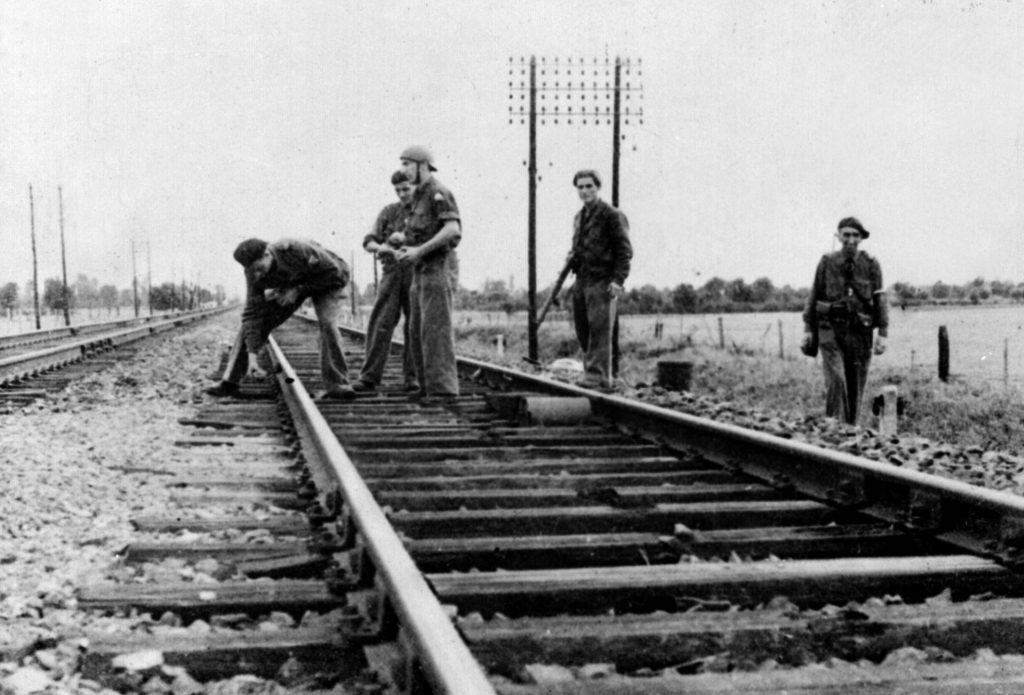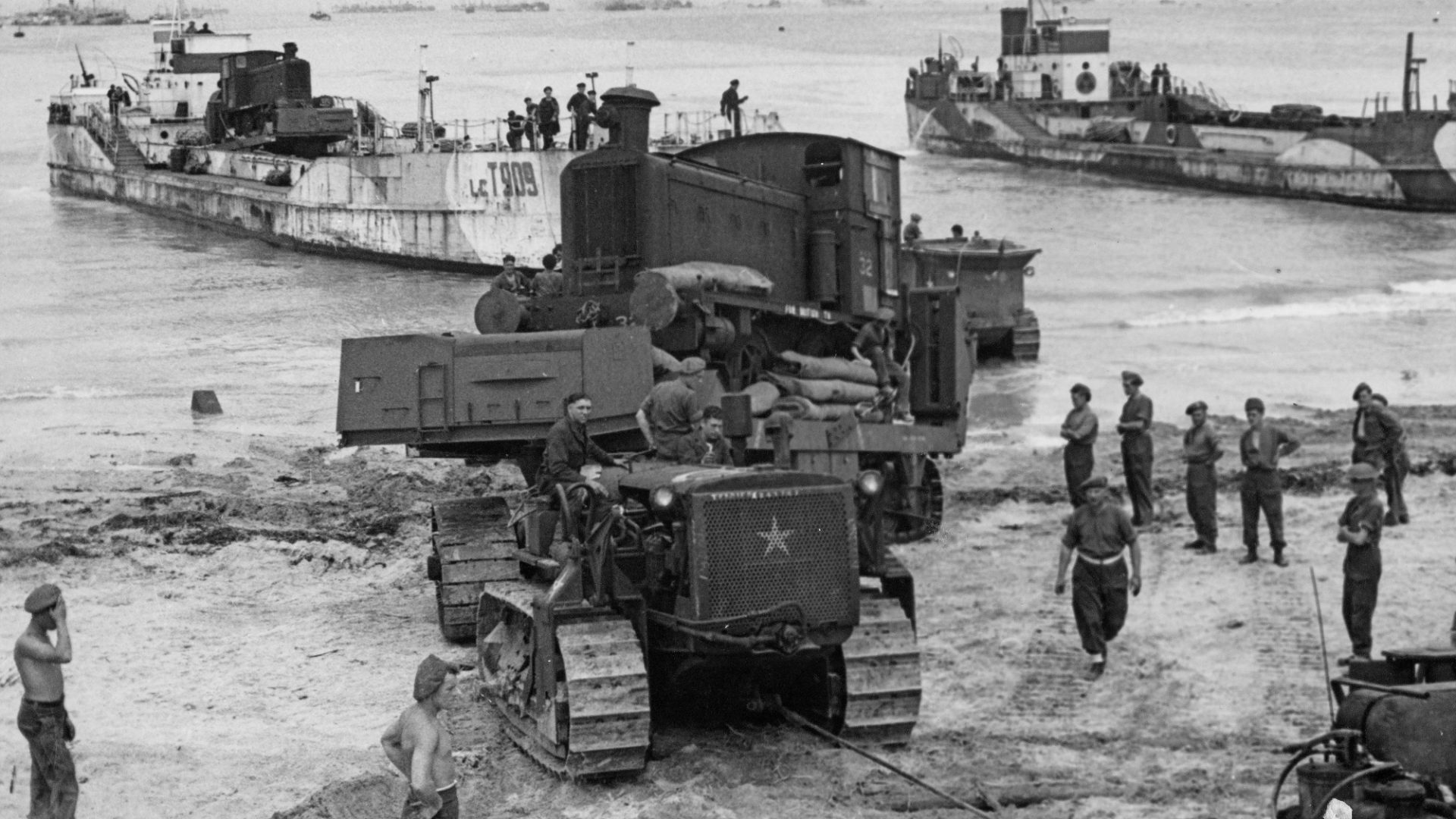“What I don’t understand is, why has no one written about this before?” asks Christian Wolmar, the acclaimed railway author, about what he says was a crucial, some might say decisive, role played by the railways in the successful D-day invasion of Europe in 1944, which eventually led to the defeat of the German war machine.
“OK, it might not have been decisive as such, but without the railways I reckon the fighting would have gone on for another year,” says Wolmar, now on his 20th railway book.
And evidence, if that’s the right word, comes from the iconic (but in this writer’s opinion truly awful) second world war movie, The Battle of the Bulge. It’s not that the role of railways gets foregrounded – it doesn’t, it gets just one 20-second clip – but what is portrayed as the crucial moment in the battle is that the defeat of Hitler’s army, in what military historians regard as the most important battle of the second world war, came about because the German tanks simply ran out of fuel.
And they ran out because the allies had successfully destroyed the rail infrastructure that would have enabled them to keep their tanks supplied with fuel.
“Logistics are crucial in wars and that’s why railways are so important,” says Wolmar. “They can move men and materiel so much faster, and in far greater quantities, than trucks. Equally, when it comes to tanks they can be moved so much faster by train, and perhaps even more importantly, tanks are very thirsty machines – maybe you can get 30 or 40 miles out of them before they need refuelling; and there’s only one way you can get the quantities of fuel that these massive tank battles involve – and that’s by rail.”
It’s a lesson the Germans learned to their cost when their attempt to invade Russia – Operation Barbarossa, the largest battle in world history – ground to a halt, in part because of their failure to keep their frontlines supplied with fuel. Nor is it a lesson that has been lost on either side in the current war in Ukraine, with the rail link between the Crimean Peninsula and Ukraine, via the Kerch Bridge, being a major focus for both sides.
Wolmar’s latest book, The Liberation Line: The Last Untold Story of the Normandy Landings, makes for a fascinating and revealing story for both second world war geeks (of which this author is not one) and also more widely, for the general reader. Who knew that the allies shipped from England to the European mainland more than 2,000 locomotives, 20,000 freight wagons, 50 ambulance trains and between 40,000 and 50,000 railwaymen – around two-thirds coming from the US?
The trains and wagons were unloaded directly on to the Normandy beaches from landing craft and then placed on tracks laid down by incredibly fast-working teams of railwaymen. These were then linked up to the main coastal railway, which, fortunately for the allies, was built close to the beaches. But that was just the start of the story.
Having gained a foothold in France, the allies’ advance across Europe was severely hampered by the appalling state of the railways.

Even if military historians have been seemingly unaware of the vital role played by railways in warfare, the protagonists in the second world war were not. Railways, and particularly the railheads, were key targets for sabotage by allied bombing raids, and by the French and Belgian resistance against the retreating German armies.
But the rate of rebuilding by the advancing railwaymen was astonishing. At one point they were so far ahead of schedule they had to wait for the advancing forces to catch up.
Wolmar’s fascination with trains goes back to his archetypal boyhood enthusiasm for train spotting, but it didn’t come to fruition until, as transport correspondent for the Independent, he was commissioned to write his first book. Since then his books on railways have ranged across the tracks from the London Underground (still his best seller) to the Trans-Siberian railway, to Engines of War – a historical sweep of the role that railways have played in warfare from Crimea to Vietnam – and the book that inspired his latest offering.
“Railways have revolutionised wars,” says Wolmar. “The battle of Waterloo lasted just a few hours, once the ammunition ran out, that was that; by contrast the battle of Verdun in the first world war lasted almost a year. Both sides were able to keep their frontlines running by supplying them by rail.”
The Liberation Line, which essentially follows the narrative of the allies’ advance into Germany, is constantly surprising. Reading the book while travelling between London and Brighton on my rail replacement bus, I could only gasp in amazement at the fact that the Americans rebuilt the 130-mile line between Avranches and Le Mans in just three days.
The railwaymen were not, or at least did not think of themselves as, frontline soldiers, but that was what they very soon became, particularly when the Germans started bombarding them with rockets.
The scale of the “success” of the V1 rockets was breathtaking. In the province of Liège – the vital strategic battleground for access to the Channel port of Antwerp – 97% of the 83,000 dwellings in the province were destroyed by them.
John Livingstone, who served with one of the American railway units, wrote: “For more than a month we have been working under the strain of frontline battle conditions. Many days our life expectancy is one minute to the next, which often is the frequency of arial or buzz bomb strikes. The trains have kept moving through it all. The train crews, yard and track men have stuck it out and each one is deserving of a medal.”
Wolmar remains impressed by the fact that once the invasion was under way, the Americans found themselves virtually running the entire network in northern Europe. He adds with some amusement: “Though that only happened once the British and French crews had convinced their American counterparts that no matter what they did on their side of the Atlantic, on this side trains run on the left.”
While it is undoubtedly the case that American crews did the lion’s share of track repair, their British counterparts also played an important role. Their specialism was building, or repairing, bridges. Through the course of the campaign they built or rebuilt no fewer than 122 bridges, many of them made up of Bailey Bridges.
These were named after Donald Bailey, whom Wolmar describes in the book as “a typical British inventor, a kind of professional amateur who tentatively put forward ideas that appeared to have been produced on the back of an envelope”. Indeed, at one stage early in his career the Treasury queried whether the defence ministry needed such a person – fortunately they told the Treasury that they did.
His revolutionary idea – the so-called Bailey Bridge – was strong enough to bear the weight of a tank and yet light enough for its components to be easily transportable. “The key to its success,” writes Wolmar “was its modular design, making it in effect a giant Meccano (or rather today, Lego) set,” he adds helpfully for his younger readers.
Bridging the Seine, one of the allies’ most important strategic goals, was achieved by means of eight Bailey Bridge sections, linked together with a central section that could be opened to allow barges to sail through. Indeed, within just a couple of months of its construction (which took just two weeks) the bridge withstood the worst floods in 30 years.
In a remarkable example of wartime ingenuity, it was kept stable and open for business by having two fully loaded wagons on either side of the central section maintaining the bridge’s stability, which were pushed and pulled by locomotives working from the banks.
Wolmar is convinced that, cyber and space wars notwithstanding, railways will remain a vital part of war and defence planning. While it is less relevant for the UK, railway warfare could again come to play a vital role in Europe where what seemed until recently only the possibility of a land war is now a harsh reality. Both Ukraine and Russia are using railways as their main means of transporting fighting men and women to their frontlines. Of equal if not greater importance, the railways are also being used to move tanks, and other heavy armour, around the country.
The question that countries near to the borders of Russia should now be asking themselves, according to Wolmar, is: “Are our railways fit for wartime purpose?” And if the answer is “not sure”, they could do worse than turn to this book for at least some of the answers.
The Liberation Line: The Last Untold Story of the Normandy Landings by Christian Wolmar is published in hardback by Atlantic Books, £25



